No party won a majority of legislative seats in yesterday’s elections, with the Democratic Progressive Party (DPP) taking 51 seats and the Chinese Nationalist Party (KMT) taking 52 seats.
During the campaign, the DPP vowed to secure more than half of the Legislative Yuan’s 113 seats, while Taiwan People’s Party (TPP) Chairman and presidential candidate Ko Wen-je (柯文哲) said that his party aimed to grab at least 10 seats. Neither met their goals.
None of the TPP’s candidates won seats in regional legislative elections.
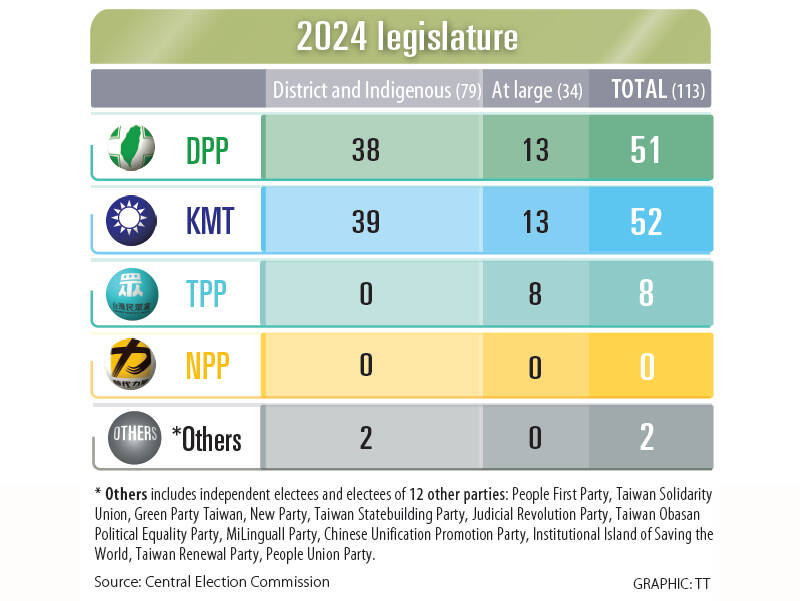
The DPP won all eight of Kaohsiung’s districts, as well as the six districts in Tainan.
Kaohsiung City Councilor Huang Jie (黃捷) — who joined the DPP last year and was nominated for Kaohsiung’s sixth electoral district after DPP Legislator Chao Tian-lin (趙天麟) dropped out of the race due to an extramarital affair — upset KMT Kaohsiung City Councilor Chen Mei-ya (陳美雅).
In Taipei’s fourth electoral district (Nangang-Neihu), DPP Legislator Kao Chia-yu (高嘉瑜), who in the previous legislative elections became the first DPP candidate to snatch a victory from the KMT in the district, failed to retain her seat, losing to KMT challenger Lee Yen-hsiu (李彥秀).
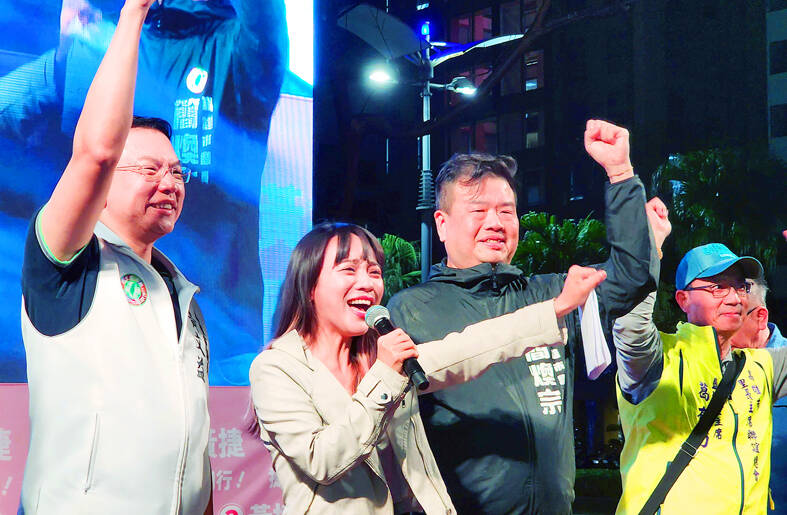
Photo: CNA
Taipei City Councilor Hsu Chiao-hsin (徐巧芯) — who secured the KMT’s nomination in Taipei’s seventh electoral district (Xinyi-Southern Songshan), stopping incumbent KMT Legislator Alex Fai (費鴻泰) from running for a sixth consecutive time — beat DPP Taipei City Councilor Hsu Shu-hua (許淑華).
DPP Legislator Lai Pin-yu (賴品妤) pulled off a surprise victory in 2020, but failed to keep her seat in New Taipei City’s 12th electoral district, losing to New Taipei City Councilor Liao Hsien-hsiang (廖先翔) of the KMT.
KMT Legislator Ma Wen-chun (馬文君) reclaimed her seat in Nantou County’s first electoral district for the fifth consecutive time, despite being accused of leaking confidential files concerning the Indigenous Defense Submarine program and illegally occupying public land. She beat Nantou County Councilor Tsai Ming-hsuan (蔡銘軒) of the DPP.
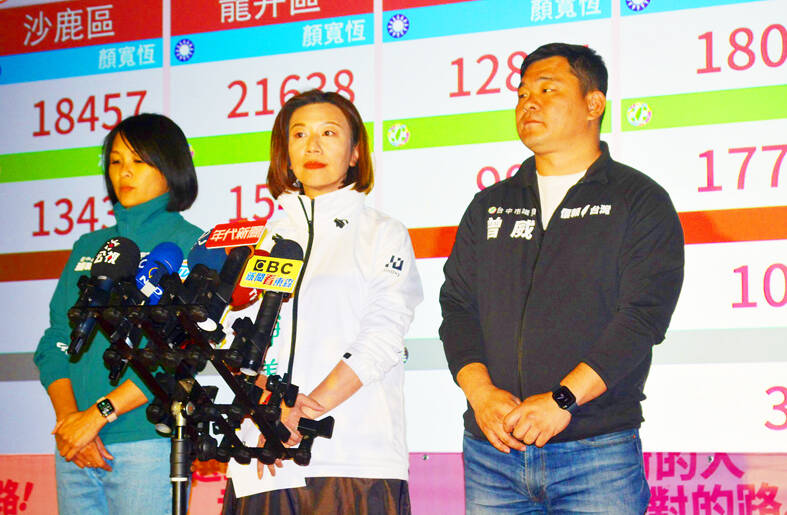
Photo: Chen Chien-chih, Taipei Times
Taitung incumbent DPP Legislator Liu Chao-hao (劉櫂豪), who ran as an independent after losing the party primary to Lai Kun-cheng (賴坤成), lost to KMT challenger Huang Chien-pin (黃建賓).
Former KMT legislator Yen Kuan-heng (顏寬恆) — accused by his opponent, DPP Legislator Lin Ching-yi (林靜儀), of corruption and dishonest property declarations — won in Taichung’s second electoral district.
TPP Legislator Tsai Pi-ru’s (蔡壁如), running in Taichung’s first electoral district, was touted as an exemplary case of KMT-TPP cooperation, gathering support from KMT heavyweights such as Taichung Mayor Lu Shiow-yen (盧秀燕). Tsai lost to Deputy Legislative Speaker Tsai Chi-chang (蔡其昌) of the DPP.
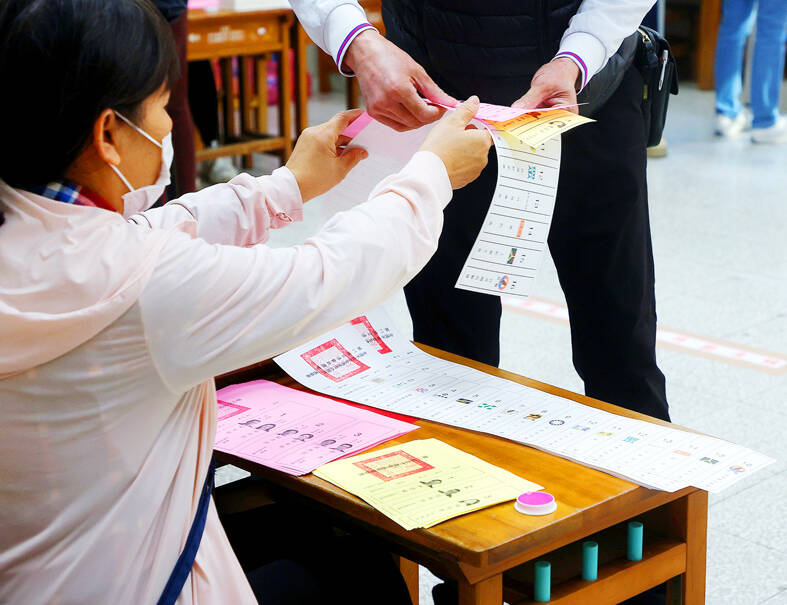
Photo: CNA
The KMT’s Sean Liao (廖偉翔), another candidate endorsed by both the KMT and TPP, beat incumbent DPP Legislator Chang Liao Wan-chien (張廖萬堅) to win Taichung’s first electoral district.
Among the 16 parties that submitted legislator-at-large candidate lists, only three — the DPP, the KMT and the TPP — crossed the 5-percentage-point threshold to be awarded seats in the legislature.
A total of 13 candidates on the DPP’s legislator-at-large candidate list secured seats with the party’s 36.16 percent of party votes.
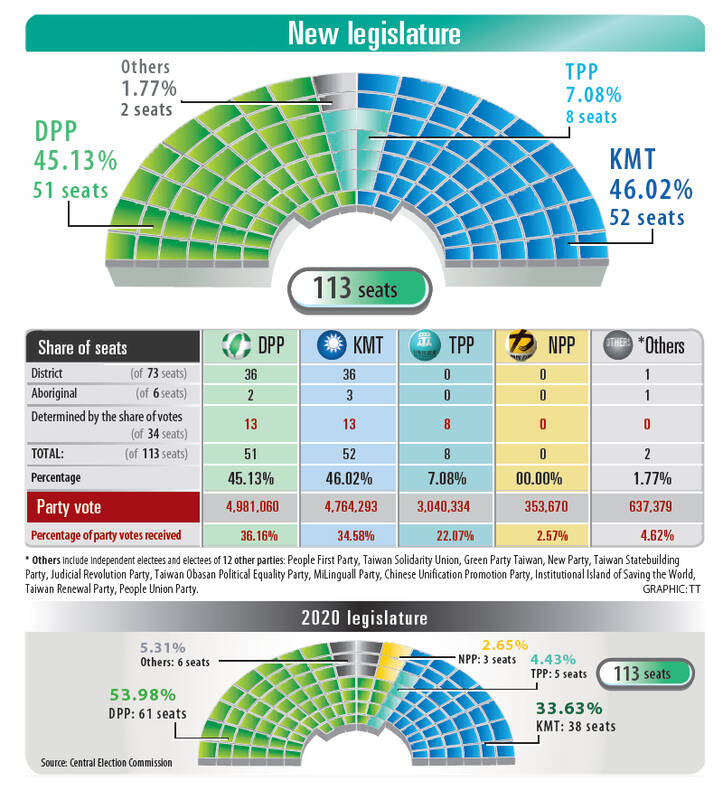
The KMT received 13 seats through 34.58 percent of party votes, while the TPP won eight seats with 22.07 percent of party votes.
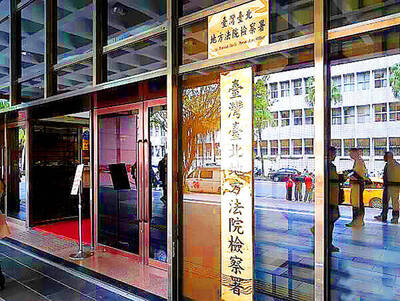
INVESTIGATION: The case is the latest instance of a DPP figure being implicated in an espionage network accused of allegedly leaking information to Chinese intelligence Democratic Progressive Party (DPP) member Ho Jen-chieh (何仁傑) was detained and held incommunicado yesterday on suspicion of spying for China during his tenure as assistant to then-minister of foreign affairs Joseph Wu (吳釗燮). The Taipei District Prosecutors’ Office said Ho was implicated during its investigation into alleged spying activities by former Presidential Office consultant Wu Shang-yu (吳尚雨). Prosecutors said there is reason to believe Ho breached the National Security Act (國家安全法) by leaking classified Ministry of Foreign Affairs information to Chinese intelligence. Following interrogation, prosecutors petitioned the Taipei District Court to detain Ho, citing concerns over potential collusion or tampering of evidence. The

Seventy percent of middle and elementary schools now conduct English classes entirely in English, the Ministry of Education said, as it encourages schools nationwide to adopt this practice Minister of Education (MOE) Cheng Ying-yao (鄭英耀) is scheduled to present a report on the government’s bilingual education policy to the Legislative Yuan’s Education and Culture Committee today. The report would outline strategies aimed at expanding access to education, reducing regional disparities and improving talent cultivation. Implementation of bilingual education policies has varied across local governments, occasionally drawing public criticism. For example, some schools have required teachers of non-English subjects to pass English proficiency

‘FORM OF PROTEST’: The German Institute Taipei said it was ‘shocked’ to see Nazi symbolism used in connection with political aims as it condemned the incident Sung Chien-liang (宋建樑), who led efforts to recall Democratic Progressive Party (DPP) Legislator Lee Kun-cheng (李坤城), was released on bail of NT$80,000 yesterday amid an outcry over a Nazi armband he wore to questioning the night before. Sung arrived at the New Taipei City District Prosecutors’ Office for questioning in a recall petition forgery case on Tuesday night wearing a red armband bearing a swastika, carrying a copy of Adolf Hitler’s Mein Kampf and giving a Nazi salute. Sung left the building at 1:15am without the armband and apparently covering the book with a coat. This is a serious international scandal and Chinese
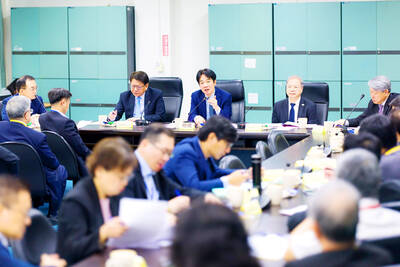
NEGOTIATIONS: The US response to the countermeasures and plans Taiwan presented has been positive, including boosting procurement and investment, the president said Taiwan is included in the first group for trade negotiations with the US, President William Lai (賴清德) said yesterday, as he seeks to shield Taiwanese exporters from a 32 percent tariff. In Washington, US Trade Representative Jamieson Greer said in an interview on Fox News on Thursday that he would speak to his Taiwanese and Israeli counterparts yesterday about tariffs after holding a long discussion with the Vietnamese earlier. US President Donald Trump on Wednesday postponed punishing levies on multiple trade partners, including Taiwan, for three months after trillions of US dollars were wiped off global markets. He has maintained a 10 percent